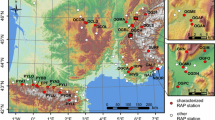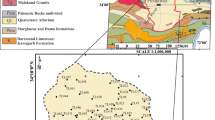Abstract
A majority of seismological studies are concerned with soil properties in low frequencies (1–10 Hz), but little is known about these properties in the audible sound domain (20–20,000 Hz). This is probably due to the high attenuation of the high frequencies within the soil, resulting in a minimal effect on buildings. For this study, 172 stations were recorded over different types of soils using variable types of P-wave and S-wave geophones to examine the variation of soil properties in the range of audible sound (20–3000 Hz). High resolution 32 bit spectrograms for the sounds recorded within every soil sample were analyzed. Moreover, a model for empty room was built in the subsurface to study changes in sound caused by the existence of large voids or cavities in the subsurface. The sound wave was able to differentiate between rigid, hard soil and softer, weaker soil. While high-strength rocks or soils tend to show sharp sound pitches (300–3000 Hz), weaker soils show lower sound pitches (20–100 Hz). The existence of subsurface voids or cavities tend to make sound pitches more regular, higher and sharper than those in the surrounding soils. This is most probably due to resonance of sound in closed places (e.g. a violin). Soil energy levels and how they change due to the soil’s excitation were studied. Soil research in the field of audible sounds is considered an emerging field with several applications (e.g. geological hazards, water exploration, and oil exploration and so on). There is a need for special high-resolution equipment to be developed for the same. This equipment should be capable of recording wide range of sound frequencies preserved in the soil and directly producing high-resolution spectrograms.























Similar content being viewed by others
References
Adib, A., Afzal, P., & Heydarzadeh, K. (2015). Site effect classification based on microtremor data analysis using a concentration–area fractal model. Nonlinear Processes in Geophysics, 22, 53–63.
Aki, K. (1957). Space and time spectra of stationary waves with special reference to microtremors. Bulletin of the Earthquake Research Institute, University of Tokyo, 35, 415–456.
Akkaya, I. (2015). The application of HVSR microtremor survey method in Yuksekova (Hakkari) region, Eastern Turkey. Journal of African Earth Sciences, 109, 87–95.
Bour, M., Fouissac, D., Dominique, P., & Martin, C. (1998). On the use of microtremor recordings in seismic microzonation. Soil Dynamics and Earthquake Engineering, 17, 465–474.
Bouranta, E., Vallianatos, F., Hatzopoulos, J.N., Papadopoulos, I., & Gaganis, P. (2013). Microtrmor HVSR study of site effects in the urban area of the town of mytilene, Lesvos (Greece)—Preliminary results, Bulletin of the Geological Society of Greece, Chania, Sept. 2013. In: Proceedings of the 13th International Congress, vol. XLVII2013.
Celebi, M., Dietel, C., Prince, J., Onate, M., & Chavez, G. (1987). Site amplification in Mexico City (determined from 19 September 1985 strong-motion records and from records of weak motion). In A. S. Cakmak (Ed.), Ground motion and engineering seismology (pp. 141–152). Ansterdam: Elsevier.
Dimitrios, D., Tzanis, A., & Makropoulos, K. (2001). Comparative study of microtremor analysis methods. Pure and Applied Geophysics, 158, 2463–2479.
Field, E. H., Hough, S. E., & Jacob, H. (1990). Using microtremors to assess potential earthquake site response, a case study in Flushing Meadows, New York city. Bulletin of the Society of America, 80(6), 1456–1480.
Harutoonian, P., Leo, C. J., Doanh, T., Castellaro, S., Zou, J. J., Liyanapathirana, D. S., et al. (2012). Microtremor measurements of rolling compacted ground. Soil Dynamics and Earthquake Engineering, 41, 23–31.
Horike, M. (1985). Inversion of phase velocity of long-period microtremors to the Swave-velocity structure down to the basement in urbanized areas. Journal of Physics of the Earth, 33, 59–69.
Ishida, H., Nozawa T., & Niwa, M. (1998). Estimation of deep surface structure based on phase velocities and spectral ratios of long period microtremors. In: Proceedings of 2nd Int. Symp, on the Effects of Surface Geology on Seismic Motion, Yokohama, Japan, 1998, 2, pp 697–704.
Jiang, Y., Gao, Y., & Wu, X. (2016). The nature frequency identification of tunnel lining based on the microtremor method. Science Direct Underground Space, 1, 108–113.
Kagami, H., Duke, C. M., Liang, G. C., & Ohta, Y. (1982). Observation of 1–5 second microtremors and their application to earthquake engineering. Part II. Evaluation of site effect upon seismic wave amplification due to extremely deep soils. Bulletin of the Seismological Society of America, 72, 987–998.
Kagami, H., Okada, S., Shiono, K., Oner, M., Dravinski, M., & Mal, A. K. (1986). Observation of 1–5 seconds microtremors and their application to earthquake engineering. Part III. A two-dimensional of the site effect in San Fernando Valley. Bulletin of the Seismological Society of America, 76, 1801–1812.
Kanai, K. (1957). The requisite conditions for predominant vibration of ground. Bulletin of the Earthquake Research Institute, University of Tokyo, 31, 457.
Kanai, K. (1961). Tanaka. On microtremors. VII. Bulletin of the Earthquake Research Institute, University of Tokyo, 39, 97–115.
Kanai, K. (1962). On the spectrum of strong earthquake motions. Primeras Journal Argentinas Ing Antisismica, 24, 1.
Lermo, J., Rodriguez, M., & Singh, S. K. (1988). The Mexico Earthquake of September 19, 1985—natural periods of sites in the valley of Mexico from microtremors measurments and from strong motion data. Earthquake Spectra, 4, 805–814.
Mahajan, A. K., Mundepi, A. K., Chauhan, N., Jasrotia, A. S., Rai, N., & Gachhayat, T. K. (2012). Active seismic and passive microtremor HVSR for assessing site effects in Jammu city, NW Himalaya, India, A case study. Journal of Applied Geophysics, 77, 51–62.
Miyakoshi, K., Kagawa, T., Kinoshita, T. (1998). Estimation of geological structures under the Kobe area using the array recordings of microtremors. In: 2nd Int Symp on the Effects of Surface Geology on Seismic Motion, Yokohama, Japan, 1998; pp. 691–696.
Mohamed, A. G., Mohamed, H. K., & George, M. (2019). Using microtremors to delineate subsurface structures in port said, north eastern Egypt. International Technology And Science Publications (ITS) Environment, 3, 11–26.
Mucciarelli, M. (1998). Reliability and applicability of Nakamura’s technique using microtremors an experimental approach. Journal of Earthquake Engineering, 4, 625–638.
Nakamura, Y. (1989). A method for Dynamic Characteristic Estimation of Subsurface using Microtremor on the ground surface. Quarterly Report of RTRI, 30, 1, 25–33
Nakamura, Y. (1997). Seismic vulnerability indices for ground and structures using microtremor. In: World Congress on Railway Research in Florence, Italy, November 1997.
Nakamura, Y. (2000). Clear Identification of Fundamental Idea of Nakamura’s Technique and its Applications, 12WCEE, 2000, 2656.
Nogoshi, M., & Igarashi, T. (1971). On the amplitude characteristics of microtremor—Part 2 (in Japanese with English abstract). Journal of the Seismological Society of Japan, 24, 26–40.
Ridwana, M., Widiyantoro, S., Afnimar, Irsyamc, M. (2015). Identification of engineering bedrock in Jakarta by using array observations of microtremors. In: 3rd International Symposium on Earthquake and Disaster Mitigation, Procedia Earth and PlanetaryScience, 2015, 12, 77–83.
Rogers, A. M., Borcherdt, R. D., Covington, P. A., & Perkins, D. M. (1984). A comparative ground response study near Los Angeles using recordings of Nevada nuclear tests and the 1971 San Fernando earthquake. Bulletin of the Seismological Society of America, 74, 19251949.
Said, R. (1990). Geology of Egypt. IN: A. A. Baklema (ed) Published for the Egyptian Petroleum Corporation. Conoco Hurghada Inc. and Repsol Exploration, S. A., Rotterdam, Brookfiekd
Scherbaum, F., Riepl, J., Bettig, B., Ohnberger, M., Cornou, C., Cotton, F., & Bard, P.Y. (1999). Dense array measurements of ambient vibrations in the Grenoble basin to study local site effects. In: AGU Fall meeting, San Francisco, December1999
Singh, A.P., Parmar A., & Chopra, S. (2017). Microtremor study for evaluating the site response characteristics in the Surat City of western India. Natural Hazards.
Yamamoto, H. (2000). Estimation of shallow S-wave velocity structures from phase velocities of love and Rayleigh-waves in microtremors. In: Proceedings of 12th World Conference on Earthquake Engineering, Auckland, New Zealand, 2000.
Author information
Authors and Affiliations
Corresponding author
Additional information
Publisher's Note
Springer Nature remains neutral with regard to jurisdictional claims in published maps and institutional affiliations.
Rights and permissions
About this article
Cite this article
Gamal, M.A., Khalil, M.H. & Maher, G. Monitoring and Studying Audible Sounds Inside Different Types of Soil and Great Expectations for its Future Applications. Pure Appl. Geophys. 177, 5397–5416 (2020). https://doi.org/10.1007/s00024-020-02583-0
Received:
Revised:
Accepted:
Published:
Issue Date:
DOI: https://doi.org/10.1007/s00024-020-02583-0




